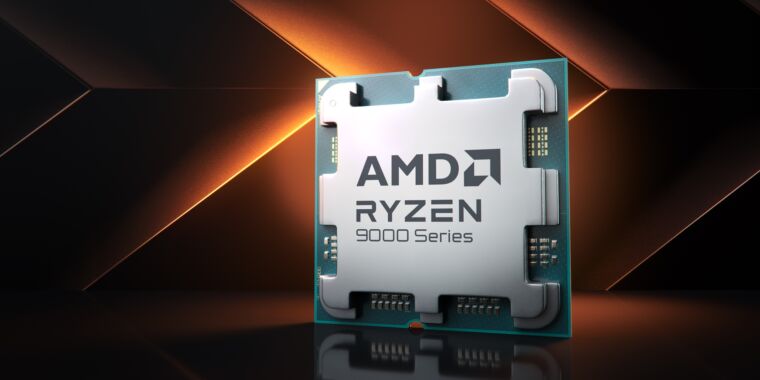-
AMD announces Ryzen 9000 and Zen 5, the second CPU architecture for its AM5 platform.
AMD
-
AMD’s Ryzen 9 9950X leads the new Ryzen 9000 family.
AMD
-
There are three other variants here, with 12, 8 and 6 Zen 5 CPU cores. The Ryzen 7000 series launched with chips at the same levels.
AMD
-
AMD is also announcing a few high-end chipsets, although they don’t offer much new; 600 series boards should all support Ryzen 9000 after a BIOS update.
AMD
-
The Zen 5 CPU architecture powers the Ryzen 9000 series.
AMD
-
A handful of architectural highlights from Zen 5.
AMD
-
The performance gains with the Zen 5 are quite impressive at times, but on average we’re looking at a 16 percent increase over the Zen 4 at the same clock speeds. That’s decent, but not as good as moving from Zen 3 to Zen 4.
AMD
It’s been almost two years since AMD introduced its Ryzen 7000 series desktop CPUs and the Zen 4 CPU architecture. Today AMD announces the first concrete details about their successors. The Ryzen 9000 CPUs will ship in July.
At a high level, the Ryzen 9000 series and Zen 5 architecture mainly offer incremental improvements over Ryzen 7000 (Ryzen 8000 on the desktop is used exclusively for Zen 4-based G-series CPUs with more powerful integrated GPUs). AMD says Zen 5 is about 16 percent faster than Zen 4 at the same clock speeds, depending on the workload – certainly not nothing, and there are some workloads that perform much better. But that number is far less than the 29 percent jump between Zen 3 and Zen 4.
AMD and Intel have both offset mild single-core performance gains in the past by adding more cores, but Ryzen 9000 doesn’t. From the 9600X to the 9950X, the chips offer between 6 and 16 full-size Zen 5 cores, the same as every desktop range since Zen 2 and the Ryzen 3000 series. Uncovered shots of the processors indicate that they still use a total of two or three separate chiplets: one or two CPU chiplets with up to 8 cores each, and a separate I/O chip to handle connectivity.
AMD
These chips do not contain Zen 5c E cores, as older rumors suggested. Zen 5c is a version of Zen 5 optimized to take up less space in a silicon chip, at the expense of higher clock speeds; Zen 5c cores make their debut in the Ryzen AI 300 series laptop chips that AMD also announced today. Increasing the number of E-cores has helped Intel match and exceed AMD’s multi-core performance, although Ryzen’s power consumption and efficiency both surpassed Intel’s during the 12th, 13th and 14th Core product cycles generation. Apple also uses a mix of P-cores and E-cores in their high-end desktop CPU designs.
Ryzen 9000 does not include any form of neural processing unit (NPU), nor does AMD mention whether the Ryzen 7000’s RDNA 2-based integrated GPU has been upgraded or improved.
AMD is also announcing new X870 and X870E motherboard chipsets to accompany the new processors; As with the
The only real improvement here seems to be that all X870 series cards support standard USB4 and higher overclocking speeds for EXPO memory. The chipsets also support PCIe 5.0 speeds for the main PCIe slot and the M.2 slot, although the X670 chipsets already did this.
The processors’ power requirements won’t change, so users with 600 series motherboards should be able to use Ryzen 9000 CPUs with little to no performance loss after a BIOS update.
-
According to this slide, AMD plans to keep the AM4 socket as a budget platform until at least 2025.
AMD
-
To that end, it’s announcing a few more riffs on the old Zen 3-based Ryzen 5000 series, to entice budget builders and upgraders. The price has not been announced.
AMD
It doesn’t seem likely that Ryzen 9000 will solve the biggest problems with the AM5 platform, namely its high cost relative to today’s generation of Intel systems, its high cost relative to today’s AM4-based systems, and even its high cost compared to AM4-based systems. systems at the same point in the life of the AM4 connection. Motherboards remain more expensive, DDR5 memory remains more expensive, and there are still no AM5 processors available for significantly less than $200.
According to AMD’s own timeline, it plans to keep the AM4 socket until at least 2025. AM4 is still a surprisingly decent budget platform considering the socket was introduced eight years ago, and AMD basically continues to trickle out new Ryzen. 5000 series CPUs to give buyers and upgraders more options. But it still means that system builders have to choose between an expensive platform that has a future, or a cheaper platform that is more or less a dead end.
List image from AMD
